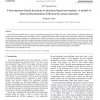Free Online Productivity Tools
i2Speak
i2Symbol
i2OCR
iTex2Img
iWeb2Print
iWeb2Shot
i2Type
iPdf2Split
iPdf2Merge
i2Bopomofo
i2Arabic
i2Style
i2Image
i2PDF
iLatex2Rtf
Sci2ools
NN
2007
Springer
2007
Springer
From memory-based decisions to decision-based movements: A model of interval discrimination followed by action selection
The interval discrimination task is a classical experimental paradigm that is employed to study working memory and decision making and typically involves four phases. First, the subject receives a stimulus, then holds it in the working memory, then makes a decision by comparing it with another stimulus and finally acts on this decision, usually by pressing one of the two buttons corresponding to the binary decision. This article demonstrates that simple linear readouts from generic neural microcircuits that send feedback of their activity to the circuit, can be trained using identical learning mechanisms to perform quite separate tasks of decision making and generation of subsequent motor commands. In this sense, the neurocomputational algorithm presented here is able to integrate the four computational stages into a single unified framework. The algorithm is tested using two-interval discrimination and delayed-match-to-sample experimental paradigms as benchmarks. c 2007 Elsevier Lt...
Decision Making | Generic Neural Microcircuits | Interval Discrimination Task | Neural Networks | NN 2007 |
| Added | 27 Dec 2010 |
| Updated | 27 Dec 2010 |
| Type | Journal |
| Year | 2007 |
| Where | NN |
| Authors | Prashant Joshi |
Comments (0)

